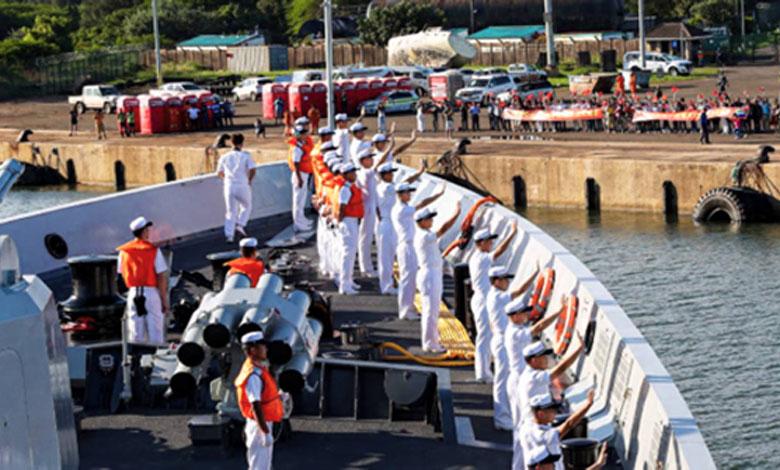Empire on concrete: how Beijing buys Africa through ports and concessions

The Celestial Empire is actively expanding its influence in the world, demonstrating both military and economic overpresence. Last time IA “FACT” wrote about the intrusive activity of the Chinese naval armada near the coast of Australia, which caused concern in the region. Another form of expansion is becoming more and more obvious – economic, in particular, on the Black Continent.
China’s Gateway to Africa: How Port Investment Becomes an Instrument of Control
Chinese companies already control 78 ports in 32 African countries, a quarter of the continent’s 231 commercial ports. This significantly exceeds the scale of their activities in other regions: in Latin America and the Caribbean, Chinese firms are involved in only 10 port facilities, and in Asia – up to 24. Such activity indicates the purposeful expansion of Beijing’s influence, which seeks to consolidate its positions in strategically important points of the world.
For every dollar invested in African port infrastructure, the Chinese receive $13 in revenue. China is not just investing in African ports. Beijing buys influence and control. Who controls the port controls access to the market. Who controls access – can dictate the conditions, decide whose ship will enter and whose will remain outside the berth. This is not a business, but a strategy.
It was quite revealing in Djibouti. When the Doraleh commercial port was built and launched in 2017, everyone said: “A big deal for trade.” And two months later, a Chinese military base appeared there. This is an unprecedentedly fast transformation of a commercial platform into a military bridgehead.
And this is not a coincidence, but a pattern that can be repeated in any other African port where China has gained access through concessions. And there are already ten such ports. So, “The Land of the Sun” continues to privatize their ports, hoping for economic benefit. But these are not just ports. This is the gateway to their independence. And if the “Cradle of Humanity” loses control over them, it will lose control over its future. China does not need permission to impose its conditions. It just uses its infrastructure.
“One belt, one road”: how China is building an empire under the guise of infrastructure projects
The Celestial Empire does not just build roads, railways and ports. Beijing is rapidly capturing the space south of the Sahara. Over the past two decades, it has become a major financier and infrastructure builder, and it’s already paying off. Research shows: where Chinese infrastructure projects are emerging, economic activity is growing. In particular, this is confirmed by the data on the increase in night lighting – plus 5% in the immediate regions and 10-15% in the neighboring ones. That is, Chinese roads, power plants, and water pipelines do not just appear on the map – they really change the economic landscape.
But there is a nuance. China is still learning to work on the global stage, and without quality management and transparency, these projects can turn into another “Potemkin village”. Therefore, Beijing should cooperate more actively with international structures and monitor the quality of projects.
China is redrawing the world map to suit its interests, creating a new geopolitical reality. And calls it beautiful – “One belt, one road“But it’s not really about friendship and trade. It’s about control, money and influence.
The “Belt and Road Initiative” is a large-scale geoeconomic project, proposed by the head of China Xi Jinping in 2013. It is designed to restore and modernize the ancient trade routes of the Silk Road, creating a global network of infrastructure, trade and investment links that will connect Asia, Europe, Africa and other regions.
Initiative covers two components. The first is the “Land Silk Road”, which includes transport corridors through Central Asia to Europe. The second – the “Maritime Silk Road” – concerns the development of ports and maritime trade routes through Southeast Asia, the Indian Ocean and further to Europe and Africa.
From 2013 to 2021, China’s trade with BRI member countries reached nearly $11 trillion, and investment exceeded $230 billion. China has invested in the creation of 79 economic zones in 24 countries, which has contributed to the development of the local economy and the creation of more than 346,000 jobs.
The BRI includes the construction of railways and highways, airports, ports, pipelines, energy facilities and logistics centers. These projects not only develop the infrastructure of the participating countries, but also strengthen political and economic ties with China.
However, the initiative has its controversial aspects. It is worth looking at Sri Lanka. China gave money for the port in Hambantota, and when the country could not repay the debt, Beijing simply took the port for itself – for 99 years. And there are dozens of such examples. Chinese investment is not charity, but a trap.
There is also growing concern that the BRI is used China not only for economic influence, but also for strategic expansion, in particular through control over key sea and land routes.
So, “One belt, one road” despite its romantic and legendary concept, is not just an economic project. It is a large-scale geopolitical strategy that changes the world. And while some think that China is just building roads, Beijing has long been building its own empire.
The China Trap: How Beijing Turns African Ports into a Tool of Control
China builds his empire methodically, without loud statements, but with deep calculation. Africa has become another front of this offensive. 78 ports in 32 countries. Chinese state corporations do not just lay concrete and build piers – they drive piles into the foundations of the sovereignty of these states. Money, concessions, control over logistics are not investments, but a strategic game.
Each port is not just a commercial infrastructure, but a potential military base, as the case in Djibouti showed. They signed a contract, built a port, declared that it was purely trade. And after a few months – a Chinese military base. And it will continue to be so. Seven ports are already ideally suited for this – from Lekki in Nigeria to Walfish Bay in Namibia. It is no longer a question of “if”, it is a question of “when”.
And what does this mean for Africa? This means dependence – on infrastructure, on financing, on politics. African governments can talk about economic development, benefits and jobs. But every Chinese dollar is a nail in the house of their independence. The more ports, the easier it is to control the flow of goods. And whoever controls trade controls politics.
And here is a question for African leaders. Do you really think China is building these ports for your prosperity? Are you sure that in 10 years your children won’t wake up in a world where their governments can’t make a single decision without Beijing’s consent?
This is not an investment, but expansion. Under the guise of business, China is deploying its military and political presence. This is a trap. And Africa is already in it. The only question is whether there will be someone who will try to break out.
…China is actively expanding its influence in Africa, using infrastructure investment as a tool of strategic control. Beijing is building ports, roads, railways, gradually creating a network of influence that threatens to turn into a geopolitical trap for the black continent. The military base in Djibouti became a precedent: first it was a commercial project, and later it was an outpost of the military force. A similar scenario is possible in other African countries. Every port, every concession is a lever of control, and the only question is whether Africa realizes that it is already involved in this long strategic game.
Tetyana Viktorova





